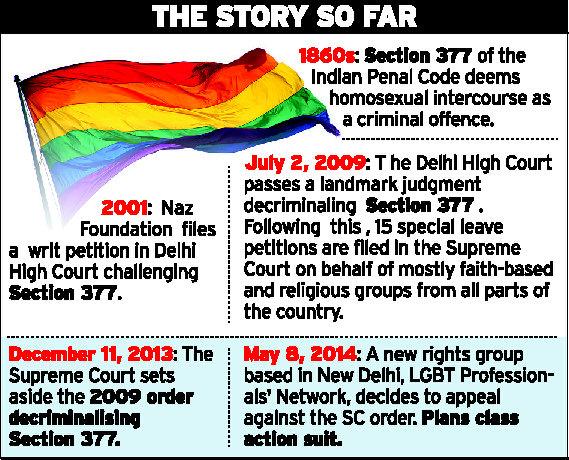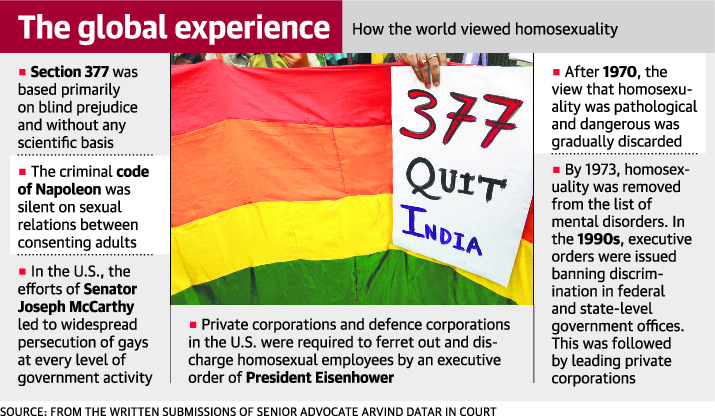IASbaba's Daily Current Affairs Analysis
IASbaba’s Daily Current Affairs (Prelims + Mains Focus)- 11th July 2018
Archives
(PRELIMS+MAINS FOCUS)
Section 377 of Indian Penal Code
Part of: GS Prelims and Mains II – Social issue; Indian Polity
In news:
- Choice of a partner is a person’s fundamental right, and it can be a same-sex partner (says SC judge at hearing on Section 377 case).
- In Hadiya case (March 2018 judgement), SC held that neither the state nor one’s parents could influence an adult’s choice of partner. That would be a violation of the fundamental right to privacy.
Section 377 of the Indian Penal Code is a colonial-era provision which criminalises homosexuality.
Hadiya, a Hindu girl from Kerala, converted to Islam and chose to marry a Muslim man.
Important Value Addition
Background:
Section 377 of the IPC states, “Whoever voluntarily has carnal intercourse against the order of nature with any man, woman or animal, shall be punished with 1[imprisonment for life], or with imprisonment of either description for a term which may extend to ten years, and shall also be liable to fine.” This archaic British law dates back to 1861 and criminalises sexual activities against the order of nature and the ambit of this law extends to any sexual union involving penile insertion.
In 2009, in a landmark judgment, the Delhi High Court described Section 377 as a violation of the fundamental rights guaranteed by the Constitution. Following this, religious groups moved the Supreme Court for a direction against the verdict.
In 2013, Supreme Court overruled the Delhi High Court’s order and reinforced criminalisation of homosexuality stating that Parliament’s job was to scrap laws. This judgment by the apex court was highly criticised by the LGBTQ community in India and was seen as a setback for human rights.

Pic: https://iasbaba.com/wp-content/uploads/2016/07/SECTION_377_COL-min.jpg
In January 2018, the Supreme Court said a larger group of judges would re-consider the previous judgment and examine Section 377’s constitutional validity.
SC bench to decide constitutionality of Section 377, whether Section 377 stood in conformity with Articles 21 (right to life), 19 (right to liberty) and 14 (right to equality) of the Constitution.

Pic: https://d39gegkjaqduz9.cloudfront.net/TH/2018/07/11/DEL/Delhi/TH/5_01/916469a0_2236431_101_mr.jpg
Article link: ‘Choosing a partner is a person’s fundamental right’ – Today’s Paper …
India and South Korea
Part of: GS prelims and mains II – International Relations; India and the World
Key pointers:
- Both the countries pledged to double trade in the next decade
The two sides signed 11 MoUs and agreements
- expanding the 2010 Comprehensive Economic Partnership Agreement
- joint vision statement that committed to more military exchanges and enhancing defence projects together
FSSAI: ‘The Eat Right Movement’
Part of: GS prelims – Health and social issue; Science and Technology
In news:
- Food Safety and Standards Authority of India (FSSAI) unveiled ‘The Eat Right Movement’, built on two broad pillars of ‘Eat Healthy’ and ‘Eat Safe’.
- The programme aims to engage and enable citizens to improve their health and well-being by making the right food choices.
- Its aim is to cut down salt/sugar and oil consumption by 30% in three years
We have already read about FSSAI’s Operation Sagar Rani, now ‘The Eat Right Movement’ programme – ‘Eat Healthy’ and ‘Eat Safe’.
Do you know?
- The draft Food Safety and Standards (Labeling and Display) Regulations 2018 made labelling of salt mandatory, introduced a special red labelling for high in fat, sugar or salt (HFSS), introduced front of pack labelling among others.
Animal in news: Sloth Bear
Part of: Environment and Biodiversity
- Sloth bears (Melursus ursinus), found only in the Indian subcontinent, were exploited as ‘dancing bears’ in India until the practice was banned in 1972. But it is not illegal in Nepal.
(MAINS FOCUS)
INTERNATIONAL
TOPIC: General Studies 2:
- Bilateral, regional and global groupings and agreements involving India and/or affecting India’s interests
- Effect of policies and politics of developed and developing countries on India’s interests, Indian diaspora.
- Important International institutions, agencies and fora- their structure, mandate.
Falling UNHRC
Introduction:
From previous articles, we read that –
United States announced its withdrawal from the United Nations Human Rights Council (UNHRC) terming it “hypocritical and self-serving.”
The withdrawal of the U.S. sent shock waves through the international community, foreign-policy think-tanks and human rights non-governmental organisations. However, some feel this was the right decision and are now advocating withdrawal by other countries; this includes those in India.
About UNHRC
- UNHRC is a United Nations body whose mission is to promote and protect human rights around the world.
- It is an inter-governmental body within the United Nations system.
- It meets at the UN Office at Geneva. The headquarters of UNHRC is in Geneva, Switzerland.
- UNHRC was established by the UN General Assembly in 2006. It is made up of 47 member nations.
Analysis of HRC functioning:
The commission’s record of performance is somewhat mixed. It has done a laudable job of creating an awareness of human rights in the country and sensitizing public servants and political authorities. But its record has been uninspiring in many other spheres of its work and, over the years, there has been a steady decline of its credibility.
- The main criticism against HRC is that – it is made up of states not known for their human rights records. (who are outstandingly bad violators of human rights – China, Cuba and Jordan)
- Current members include Saudi Arabia, the Philippines, Pakistan, and the United Kingdom — a few of the 47 states elected by the General Assembly, based on geographic quotas. (increased number of non-Western members)
- Countries grossly violating human rights are still elected as members to the body.
- UNHRC’s agenda is considered biased by the US and other countries.
- The ‘Universal Periodic Review’ process, where all states are scrutinised, is currently in its third cycle (2017-2021). No state is exempt from this process, including Security Council members.
- The special procedures system of fact-finders and analysts is breaking down under its own weight and lack of rigor in many instances.
- It has neglected, for instance, Egypt’s draconian four-year crackdown to crush all dissent and Venezuela’s decimation of its once-vibrant democracy.
Some of the achievement of Commissions
Resolutions adopted by the commission have highlighted most important subjects dealing with – Myanmar’s ethnic cleaning of its Rohingya population, Syria’s targeting of hospitals and other civilian institutions, the Saudi-led coalition’s bombing and starving of Yemeni civilians, and South Sudanese fighters’ slaughter of civilians because of their ethnicity. (including LGBTIQ rights and discrimination on the basis of religion)
Another aspect overseen by the HRC is the appointment of special rapporteurs — independent mandate holders — on issues including internal displacement, torture, racial discrimination, as well as country specific mandates.
Connecting the dots:
- ‘Rising humanitarian crisis and afflictions on people pose a serious question on working of international organizations in the name of Human Rights Organizations’. In the light of the statement, critically discuss the role of United Nations Human Rights Commission (UNHRC) and other similar organizations. Do you think such organizations have proved inefficient?
- “The UNO needs structural and functional reforms that are needed to be infused into as new issues and forces impinge on its functioning”. Comment
SCIENCE AND TECHNOLOGY/DISASTER MANAGEMENT
TOPIC: General Studies 3:
- Achievements of Indians in science & technology; indigenization of technology and developing new technology.
- Awareness in the fields of IT, Space, Computers, robotics, nano-technology, bio-technology and issues relating to intellectual property rights.
- Disaster and disaster management.
Role of Big Data in saving lives
Since 1970, more than two million people have been killed by natural disasters, especially in the ‘Ring of Fire’ region around the Pacific Ocean.
As per UN report, approximately 43,000 a year have been killed.
In 2004 alone, the Indian Ocean tsunami struck 14 countries, and killed more than 18,000 people in India.

Role of Big Data:
There is a way to dramatically cut down on the number of people impacted by such disasters, and that is by using data.
If we are to save lives and prevent damage to economies, it is critical to identify the most vulnerable populations. Data on these communities can be used to pursue ‘risk-informed development’.
- For instance, road infrastructure can be built by calculating the intensity of floods and determining the types of materials needed to construct durable roads.
- India recently embarked on an initiative to establish a comprehensive disaster database system.
- Now, the United Nations Development Programme (UNDP), working with partners, has established National Disaster Loss and Damage databases in 16 countries.
Data also help identify the gaps and makes recommendations on where to allocate resources to mitigate risks from disasters.
- For example, flood-resistant roads can only be constructed if governments consider and review data about flood risks.
- With such information, they can allocate appropriate funds for better road construction.
Institution to study risks
- In 2015, the UNDP partnered with the Tohoku University and Fujitsu decided to create a Global Centre for Disaster Statistics (GCDS).
- The aim is to gather and crunch ‘big data’ to meet the ambitious targets of the Sendai Framework to reduce the risks from disasters.
- Fujitsu’s cloud-based ecosystem captures data from a variety of sources, including unstructured sources like social media, high-resolution satellite imagery and drones.
- Specialised technical institutions like the Tohoku University can crunch and analyse these data sets to provide insights for policymakers about the impacts of disasters. This includes helping to monitor recovery, focussing on early warning, and assessing resilience.
Conclusion:
Big data also provides a deeper understanding about how an economy is interconnected: how devastation of a rice crop by a disaster can trigger a chain impact across several industries and services, such as transportation, rice-trading, packaging and retail.
With such valuable information, governments can anticipate disasters and reduce risks through preventive measures such as early warning systems, safety drills, and resilient infrastructure.
Connecting the dots:
- What is Big Data? Discuss it’s significance and possible applications.
(TEST YOUR KNOWLEDGE)
Model questions: (You can now post your answers in comment section)
Q.1) Koushal judgement is related to
- Disability community
- Women Harassment
- Child Labour
- LGBT community
Q.2) Sahyog-HYEOBLYEOG’ is joint exercise between Indian and
- Japan
- China
- CLMV Countries
- South Korea
Q.3) China is bordered with which of the following countries?
- South Korea
- Afghanistan
- Vietnam
Select the correct statements
- 1 and 2
- 2 and 3
- 1 and 3
- All of the above
Q.4) India has negative bilateral trade balance with
- China
- Bangladesh
- Nepal
- South Korea
Select the correct code:
- 1, 2 and 3
- 1, 2 and 4
- 1 and 4 Only
- All of the above
Q.5) Consider the following statements about Universal Periodic Review (UPR)
- It is established by the Geneva-based UN Human Rights Council (HRC)
- It is a process in which human rights record of each of the UN’s member countries is peer-reviewed every four or five years
- The recommendations accepted at the UPR in HRC are binding in nature
Select the correct statements
- 1 and 2
- 2 and 3
- 1 and 3
- All of the above
MUST READ
U.K. failed to have a proper conversation on immigration
Is China meritocratic?
The only way out
Sowing Slogans
Nothing to hide
Bullet train to start in 2022













